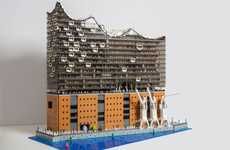
The Cornebarrieu School Complex Tackles Environmental Challenges
References: duncan-lewis & archdaily
The Cornebarrieu School complex in France is built directly in response to the modern problems associated with climate change, instilling a sense of ecological responsibility in its students by dint of its very existence. The complex employs sustainable ecological, social, and economic strategies in its makeup.
There are over 500 trees standing nine meters or taller on the Cornebarrieu School complex. Not only does this treed environment give a de facto appreciation of nature, but they also serve a practical purpose. The shade from these strategically placed trees helps reduce the mean temperature in the complex by three degree Celsius during the summer, reducing the cost and energy that would otherwise be spent on air conditioning. Further, the walls of the classrooms are made from a translucide membrane that retains temperature while also allowing natural light to enter (and thus reducing the need for overhead lighting).
There are over 500 trees standing nine meters or taller on the Cornebarrieu School complex. Not only does this treed environment give a de facto appreciation of nature, but they also serve a practical purpose. The shade from these strategically placed trees helps reduce the mean temperature in the complex by three degree Celsius during the summer, reducing the cost and energy that would otherwise be spent on air conditioning. Further, the walls of the classrooms are made from a translucide membrane that retains temperature while also allowing natural light to enter (and thus reducing the need for overhead lighting).
Trend Themes
1. Eco-friendly Architecture - The trend of incorporating sustainable and eco-friendly elements into architectural designs offers opportunities for innovative and environmentally responsible building solutions.
2. Biophilic Design - The trend of integrating nature and natural elements into design not only enhances aesthetics but also provides practical benefits such as energy efficiency and improved well-being.
3. Climate-responsive Infrastructure - The trend of developing infrastructure that adapts to climate change challenges presents opportunities for creating more resilient and sustainable built environments.
Industry Implications
1. Architecture - The architecture industry can leverage the trend of eco-friendly and biophilic design to create innovative and sustainable building solutions.
2. Education - The education industry can explore the potential of climate-responsive infrastructure to create environmentally friendly and energy-efficient learning environments.
3. Sustainable Development - The sustainable development industry can benefit from the trend of incorporating eco-friendly elements into infrastructure projects to create more resilient and environmentally responsible urban areas.
2.2
Score
Popularity
Activity
Freshness























